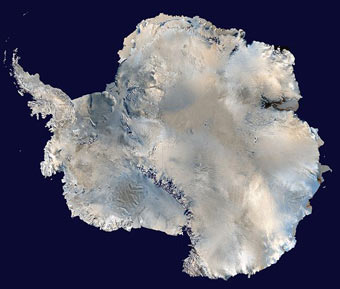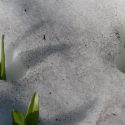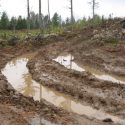New Antarctica research season kicks off
The approach of winter in the northern hemisphere means that summer is coming to Antarctica — still bitterly cold, but just warm enough to let scientists make progress on ongoing studies.
Among those UW–Madison faculty members who conduct research at the bottom of the word are Jim Bockheim, an expert on Antarctica’s Mars-like soils; Christine Ribic, a wildlife ecologist who studies the super-hardy Adelie penguin; and Charles Bentley, a geologist who is celebrating his 50th anniversary as an Antarctic scientist this year.
This research season also marks the midway point of the International Polar Year (IPY), which extends from March 2007 to March 2009. Organized through the International Council for Science and the World Meteorological Organization, the IPY is a large scientific program dedicated to the Arctic and the Antarctic. The 2007-09 "year" follows previous polar years in 1882-83, 1932-33, and 1957-58.
As visitors soar, scientist maps Antartica’s sensitive soils
Jim Bockheim has trekked to some of the coldest, driest places on earth. As a polar soil scientist, he has spent more than three decades studying glacial cycles and how soils form in these extreme climates. But these days, the ends of the earth are becoming more crowded.
In 2006, almost 30,000 travelers journeyed to Antarctica to see penguins, whales and the South Pole. This kind of adventure doesn’t come cheap. Excursions range from $4,000 to $30,000 per trip. For that price, eco-tourists can play scientist, visit research stations, commune with seals, and even climb unnamed mountains.
Bockheim worries about the impact of this activity on a fragile ecosystem. Polar soils are unique he says. He should know: Bockheim played a key role in naming this soil class-the gelisols-in 1998. Perpetually frozen, Antarctic gelisols have been likened to the soils on Mars. They are also sensitive to human impact.
To that end, Bockheim is collaborating with colleagues from New Zealand and several international organizations to develop comprehensive maps of Antarctica’s permafrost and soils. These maps might soon be used to develop a trail system for visitors.
"If tourism becomes more extensive," Bockheim says, the maps can show "where the best place would be to lay these trails out with minimum impact."
But Bockheim isn’t just worried about the impacts of tourists. Research in Antarctica has also increased. McMurdo Station, Antarctica’s largest settlement, now hosts more than 1,000 scientists and support staff year round. And they require amenities such as research labs, dormitories, a bowling alley, satellite television, and a diesel generator for electricity.
Many of these scientists study climate change effects. Bockheim is no exception. Part of his research examines glacial cycles, which he hopes can provide information about future climate events. A better understanding of what caused mass glaciation in the past, he says, can help better predict when it could happen again. The clues are in the soils. And they need protection.
With an increased focus on preserving the ecosystem of the "last continent," scientists are becoming more careful about how they do business in Antarctica. Each small change is significant.
"Every time I dig a soil pit, I’m conducting some kind of disturbance," Bockheim says. "So now, we dig the soil layers very carefully and put them on a tarp." After collecting samples and data, his team gently replaces all the soil and stones. They even pack out their own human waste.
It takes days for Bockheim to get to his remote location in Antarctica’s Dry Valley, but it’s worth it. His benefits include interesting and meaningful research, great scenery, and a mountain with his name on it: Mount Bockheim.
"It’s spectacular," he says of the experience. "I’m interested in life at the extremes."
Not so happy feet: Retreating sea ice bad news for penguins
As penguins go, the Adelie is one tough bird. Standing about 2 1/2-feet tall, the diminutive Adelie is one of just a few animals to brave the Antarctic winter, hanging around to feast on krill while other species depart for warmer destinations.

Adelie Penguin
Photo: Stan Shebs
But the Adelie depends on constant sea ice for its successful Antarctic lifestyle, and changes in the marine ice related to global climate change may doom rookeries that have been used by the flightless birds for more than 8,000 years, according to new research.
"The Adelie is integrating all the effects of climate change. They have to deal with it," explains Christine Ribic, a UW–Madison wildlife ecologist who studies the penguin’s habitat on the western Antarctica Peninsula. "This is a real ice species."
Ribic and others worry that the Adelie rookeries nearest the U.S. Palmer Antarctic Research Station on Anvers Island will disappear as sea ice retreats south and be replaced by other penguin species — the chinstrap and Gentoo — which are more tolerant of open water. "The fear is that in 5 to 10 years on Anvers Island, the Adelie will go extinct at those sites," she says.
There are five Adelie rookeries on the peninsula, including those on Anvers Island, and all are within easy reach of an ocean trough where upwelling currents provide nutrients for krill, shrimp-like crustaceans that are the preferred prey for the Adelie.
Recent mapping of the ocean floor, coupled with tracking of satellite-tagged penguins, has revealed the importance of troughs to the rookeries, Ribic says. "Now we know what the ocean floor looks like. For example, the trough at Anvers Island is within 15 to 20 kilometers of where the penguins are. The penguins are limited to regions where prey is available, and that is predictable in terms of centuries."
The good news, according to Ribic, is that if the Adelie rookeries near Palmer "wink out," they could return — as long as there is enough sea ice for the penguins to maintain their lifestyle and out-compete their flightless cousins.
Drilling into Antarctica’s past
A team of UW–Madison scientists and engineers is traveling to the West Antarctic Ice Sheet this winter for the inaugural Antarctic run of a powerful new ice-coring drill, called the Deep Ice Sheet Coring (DISC) Drill.
Developed at UW–Madison’s Space Science and Engineering Center by a team led by project manager Alexander Shturmakov, the drill will enable scientists to collect and analyze high-quality cores of the Antarctic ice and bedrock.
Over the course of three work seasons, the team aims to drill through the entire depth of the West Antarctic Ice Sheet, a distance greater than two miles. In subsequent years, they also hope to collect cores from the underlying bedrock — a feat that has never been accomplished in Antarctica.
Ice sheets contain a record of past climates and environments. As layers of snow were compressed into ice, they trapped air bubbles, minute quantities of chemical impurities and biological samples that now offer a look back through Antarctic history.
An interdisciplinary team of scientists from a score of institutions will use the DISC drill cores to study past relationships between geology, biology and climate. They also plan to compare their Antarctic findings to similar data from Greenland ice cores to determine the relationship between environmental changes in the northern and southern hemispheres.
The project team is targeting a region of the West Antarctic Ice Sheet that receives high annual snowfall, which creates thick and more easily analyzed yearly ice layers. Cores from this region should provide a view of past climates with a level of detail unprecedented in Antarctica, with single-year resolution for the past 40,000 to 50,000 years.
Charles Bentley, principal investigator for the DISC drill project and professor emeritus of geology and geophysics, will be traveling to the drilling site from Jan. 12-19, 2008, to see the drill in operation for the first time. This season marks the 50th anniversary of Bentley’s first full field season in Antarctica in 1957-58.




